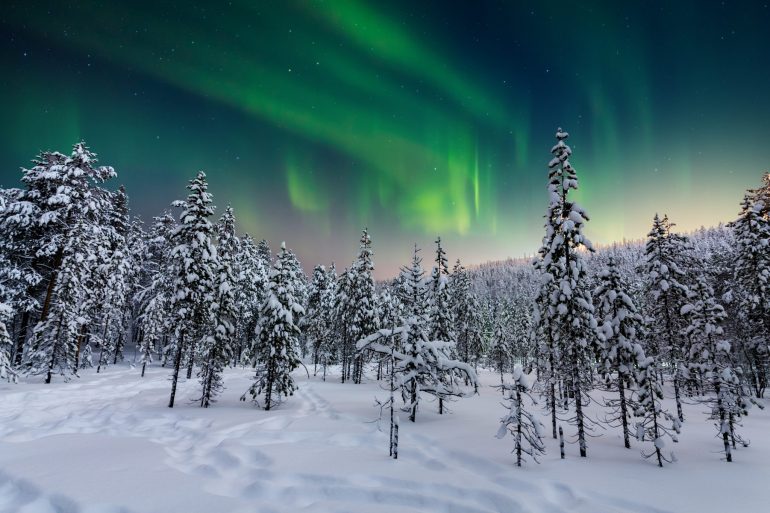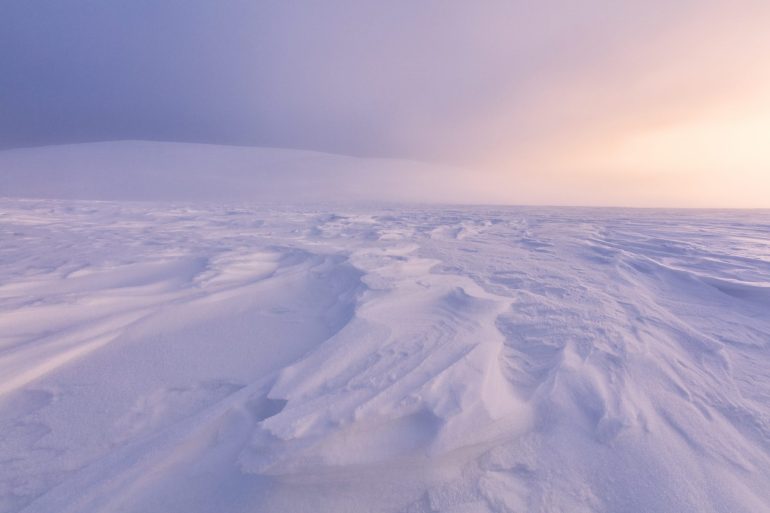At the mention of Finland, one might picture the ethereal glow of the Northern Lights or endless stretches of serene lakes and dense forests. Bordered by Norway, Russia, and Sweden, as well as stretches of the Gulfs of Finland and Bothnia, it primarily comprises lowlands, but it also holds within its borders summits that ascend over 3,000 feet.
The biggest mountains of Finland, predominantly classified as fells, rise majestically, standing as sentinels of the Arctic Circle in the province of Lapland. In fact, every mountain on this list is found in the municipality of Enontekio, home to 60 percent of Finland’s fells.
And now, with the stage set, let’s journey to the tallest mountains in Finland.
Halti: The Pinnacle of Finnish Mountains

Halti, Finland. (Credit: Mikko Karjalainen via Getty Images)
Standing tall as the crown jewel among Finland’s highest mountains is Halti. A unique fell also known by its Northern Sami name, Halditsohkka, it extends its terrain across both Norway and Finland. And, while its highest peak is in Norway, the Finnish side boasts a height of 4,344 feet above sea level, rightfully claiming the title of the tallest mountain in Finland.
In 2015, Norwegians proposed gifting the peak to Finland for its 2017 centenary by altering the border. The gesture garnered immense support, but Norway eventually chose to let the borders be.
Ridnitsohkka: A Finnish Behemoth

Mountain in Finland with Northern Lights. (Credit: Anton Petrus via Getty Images)
Stretching 4,320 feet above sea level, not only is Ridnitsohkka second on the list of the tallest mountains in Finland, but it’s also the highest mountain entirely within its borders. With a prominence of 614 feet from base to summit, it offers a unique view – a steep face on the east and a gentler slope on the west. As if this wasn’t enough, it’s also the location of Finland’s highest building – a base station for the telephone network. And despite its remote location, emergency services can be accessed here, thanks to the telecommunications mast.
Kiedditsohkka: The Third Giant

Snow capped mountain in Finland. (Credit: Anton Petrus via Getty Images)
Kiedditsohkka, or Gieddecohkka as it’s also known, is another jewel in the diadem of mountains in Finland. With an elevation of 4,216 feet, it claims the third spot in our list of Finland’s tallest peaks. Kiedditsohkka captivates visitors with its rugged slopes and the rich biodiversity that thrives in its vicinity, offering a splendid showcase of Finland’s arctic flora and fauna.
Ruvdnaoaiiv: A Side Peak Wonder

Mountain top cabin in Finland. (Credit: Anton Petrus via Getty Images)
A side peak of Ridnitsohkka, Ruvdnaoaiiv forms an integral part of the landscape of the highest mountains in Finland. Rising 4,049 feet above sea level, it might not reach the towering heights of Halti or Ridnitsohkka but stands majestic in its own right. While lesser-known compared to its towering neighbours, Ruvdnaoaiiv remains an essential part of Finland’s mountainous landscape, characterised by its distinct ridges and the serene wilderness that surrounds its base.
Kovddoskaisi: A Majestic Standpoint

Sunset over Finnish Mountains. (Credit: Anton Petrus via Getty Images)
Tied in height with Ruvdnaoaiiv at 4,049 feet, Kovddoskaisi is uniquely recognized for its massive prominence of 1,443 feet from base to summit. Distinguished by its towering prominence, Kovddoskaisi is an example of Finland’s geologically diverse landscapes, with its base ensconced in verdant greenery that transition into alpine terrains. This peak offers another perspective on the variety and grandeur of Finland’s highest mountains.
The Biggest Mountains of Finland

Pallas-Yllastunturi National Park, Muonio, Lapland, Finland (Credit: Roberto Moiola / Sysaworld via Getty Images)
Concluding our journey, we find that the frozen giants that make up the highest mountains in Finland are a testament to the country’s varied topography. The undulating terrains of these highlands provide a fascinating contrast to the otherwise flat landscapes that dominate much of the country.
Halti stands out, not just for its stature, but also for its bi-national presence, gracing both Norwegian and Finnish terrains. Its elevation and prominence make it an iconic symbol of Finland’s rugged northern landscapes.
Ridnitsohkka, the highest point entirely within Finland, is noteworthy not just for its height but also for the perspectives it offers, with varying gradients from its east to west faces. Its role in hosting Finland’s highest building, a testament to human ingenuity even in remote terrains, cannot be overlooked.
Kiedditsohkka and Ruvdnaoaiiv, though not the highest, still stand as formidable peaks in their own right. Their elevations and distinct features add layers of depth to Finland’s mountainous landscape. Kovddoskaisi, with its remarkable prominence, offers a glimpse into the diverse structures of the Finnish fells.
In essence, the majesty of Finland’s mountains lies not just in their height, but in their unique characteristics and the range they bring to the country’s varied topography. The fells stand as silent witnesses to millennia of geological events.











